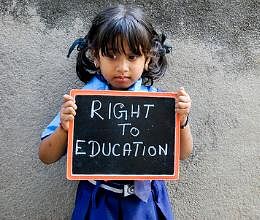
With much of the success of Right to Education (RTE) Act hinging on the learning outcome, the government is contemplating to formulate ''national standards for schools'' performance to keep students and parents well informed.
“The initiative will bring out schools which are performing well and which are not doing that good so that parents are well informed,” senior HRD Ministry official Brinda Swarup told a convention here.
The move assumes significance in light of reports which suggest that learning outcome is still far from satisfactory in both primary and upper primary classes.
The convention was organised by National Commission for Protection of Child Rights (NCPCR) and UNICEF to evaluate the progress of RTE after three years and the performance of the states especially after the three-year deadline to implement the infrastructure requirement came to an end on March 31, 2013.
Inaugurating the meet, Women and Child Development Minister Krishna Tirath she said NCPCR and State Commission for Protection of Child Rights should also monitor out-of- school children to facilitate their access and participation in the schooling system.
Swarup noted that though a lot has been achieved in meeting the RTE parameters, much more grounds need to be covered. She said that as against the target of 19.82 lakh teachers, 14.80 lakh have been recruited as of September 30, 2013.
She said 90 per cent of the schools across the country have toilet facilities while 95 per cent have drinking water supply. Additional classrooms have been also been added.
She in particular highlighted the role of Maharashtra and Madhya Pradesh in implementing the 25 per cent reservation for students from the fringes of society in neighbourhood schools.
During 2013-14, 2,08,731 primary schools and 1,59,731 upper primary schools were sanctioned, she said.
On the key issue of redressal system for better implementation of the RTE mandate, she said 19 states have set up decentralised grievances redressal systems while 34 states have set up school management committees, notifying their roles and responsibilities.
Secretary (School Education and Literacy) R Bhattacharya said 98 per cent of the habitation in the country have elementary schools as of today within 1 km and 92 per cent have upper primary schools within 3 km of their locations.
“The initiative will bring out schools which are performing well and which are not doing that good so that parents are well informed,” senior HRD Ministry official Brinda Swarup told a convention here.
The move assumes significance in light of reports which suggest that learning outcome is still far from satisfactory in both primary and upper primary classes.
The convention was organised by National Commission for Protection of Child Rights (NCPCR) and UNICEF to evaluate the progress of RTE after three years and the performance of the states especially after the three-year deadline to implement the infrastructure requirement came to an end on March 31, 2013.
Inaugurating the meet, Women and Child Development Minister Krishna Tirath she said NCPCR and State Commission for Protection of Child Rights should also monitor out-of- school children to facilitate their access and participation in the schooling system.
Swarup noted that though a lot has been achieved in meeting the RTE parameters, much more grounds need to be covered. She said that as against the target of 19.82 lakh teachers, 14.80 lakh have been recruited as of September 30, 2013.
She said 90 per cent of the schools across the country have toilet facilities while 95 per cent have drinking water supply. Additional classrooms have been also been added.
She in particular highlighted the role of Maharashtra and Madhya Pradesh in implementing the 25 per cent reservation for students from the fringes of society in neighbourhood schools.
During 2013-14, 2,08,731 primary schools and 1,59,731 upper primary schools were sanctioned, she said.
On the key issue of redressal system for better implementation of the RTE mandate, she said 19 states have set up decentralised grievances redressal systems while 34 states have set up school management committees, notifying their roles and responsibilities.
Secretary (School Education and Literacy) R Bhattacharya said 98 per cent of the habitation in the country have elementary schools as of today within 1 km and 92 per cent have upper primary schools within 3 km of their locations.








